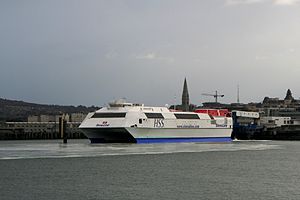HSS 1500
 Stena Explorer at Dún Laoghaire
| |
| Class overview | |
|---|---|
| Name | HSS 1500 |
| Builders | Finnyards, Finland |
| Operators |
|
| Built | June 1994 - April 1997 |
| In service | April 1996 - September 2014 |
| Planned | 4 |
| Building | 1996 |
| Completed | 3 |
| Cancelled | 1 |
| Laid up | 1 |
| Retired | 3 |
| Scrapped | 2 |
| General characteristics | |
| Type | High-speed catamaran |
| Tonnage | 19,638 GT |
| Displacement | 90.50 |
| Length | 126.6 m (415 ft 4 in) |
| Beam | 40.0 m (131 ft 3 in) |
| Draught | 4.8 m (15 ft 9 in) |
| Depth | 100m |
| Decks | 7 |
| Deck clearance | 30 min |
| Ramps | 3 |
| Installed power | |
| Propulsion | 4x Kamewa Type S Waterjets |
| Speed | Unladen record 51 knots [citation needed] |
| Capacity |
|
| Notes | The Stena Explorer is mainly laid up, it only sails in Summer now. |
HSS 1500 was the name of a model of Stena HSS craft developed and originally operated by Stena Line on European international ferry routes. The vessels were the largest high-speed craft in the world. Several design patents were registered to Stena Line in the development of the HSS.
Three vessels were ultimately completed in 1996 and 1997. The first of the class, Stena Explorer, entered service in April 1996, serving the Holyhead - Dún Laoghaire route from 1996 to 2014.[1][2] Two others had served Stranraer to Belfast and Harwich to Hook of Holland.[3] On the 200-kilometre Hoek–Harwich route, the Stena HSS had cut the crossing time in half by cruising at 41 knots.[3][4]
Design and construction
[edit]Stena Explorer was constructed by Finnyards in Rauma, Finland.[5][6]
The HSS 1500 is a semi-small-waterplane-area twin hull (SWATH) catamaran, and was designed with the aim of providing a comfortable and fast service.[7]
Power is provided by four GE Aviation gas turbines in a twin COGAG configuration.[8] The vessels employ four Kamewa waterjets for propulsion.[1]
The HSS class of ferries were designed to allow quick turnarounds at port, in 30 minutes or less.[3] A specially designed linkspan for the Stena HSS provides ropeless mooring and allows quick loading, unloading and servicing. Vehicles are loaded via two of the four stern doors and park in a "U" configuration. When disembarking, vehicles drive straight off via the other two doors.[1]
Ships
[edit]- Stena Explorer (now: One World Karadeniz) - Sold for use as office space in Turkey
- Stena Voyager - scrapped in Sweden
- Stena Discovery (later: HSS Discovery) - scrapped in Turkey
References
[edit]- ^ a b c "Stena Explorer". Sealink-Holyhead. Retrieved 24 December 2009.
- ^ Ashmore, Jehan (June 2015). "Farewell to Stena's HSS". Ships Monthly. Retrieved 4 December 2022 – via archive.org.
- ^ a b c "Fast Ferries", by Ian Manser, in The Global Change?, International Ports Congress 1999, page 43. Online at Google Books.
- ^ "A Ferry for the Future", Bonaire Reporter, 2001-05-02. Retrieved 2011-10-25.
- ^ "Stena Explorer". DNV Exchange. Det Norske Veritas. Retrieved 24 December 2009.
- ^ "Stena Explorer" (in Swedish). Fakta Om Fartyg. Retrieved 24 December 2009.
- ^ "The story behind the building of the first Stena HSS". Dun Laoghaire Harbour Company. Archived from the original on 8 December 2009. Retrieved 24 December 2009.
- ^ "GE Marine Engines' LM Gas Turbines Exceed 600,000 Hours Operating Aboard 16 Fast Ferries" (Press release). GE Aviation. 9 September 2002. Archived from the original on 11 December 2010. Retrieved 24 December 2009.
Each semi-swath fast ferry has two LM1600 and two LM2500 gas turbines in a COmbined Gas and Gas (COGAG) turbine configuration.
